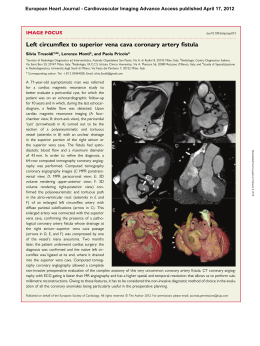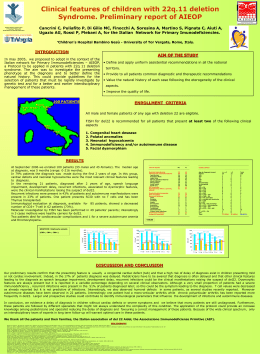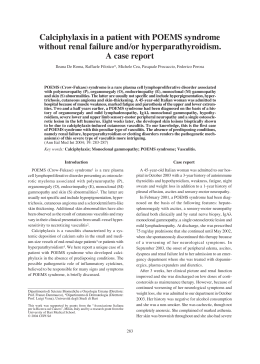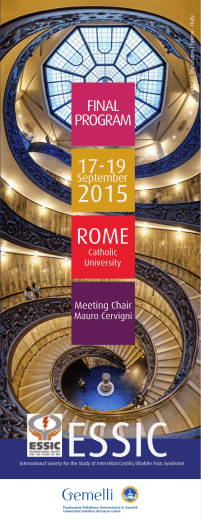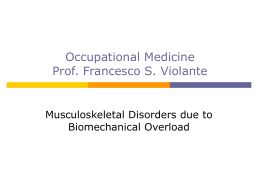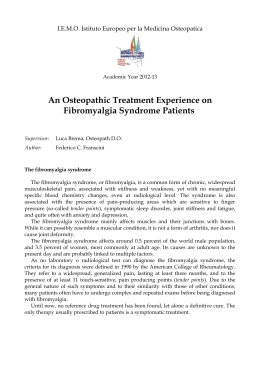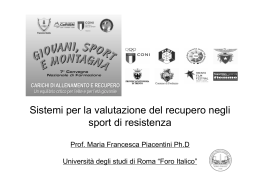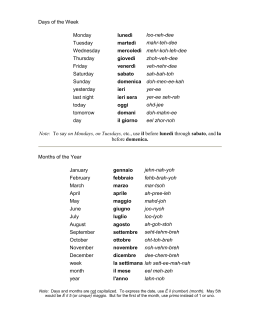Cesare Fiorentini Medicina di genere e malattie cardiovascolari 18 gennaio 2014 - Pio Albergo Trivulzio - Milano - ACCURACY OF MDCT: complementary role of stress test Female, 44 years old with hypertension, atypical angina, ex-ECG positive and stress nuclear test positive in inferior wall of LV Circulation 2006; 113 Transient Left Ventricular Apical Ballooning Syndrome 1. 2. 3. 4. 5. Gender: 6-fold female-to-male predominance Mean age >60 years Acute substernal chest pain ST-segment elevation and/or T-wave inversion Absence of significant coronary arterial narrowing at angiography 6. Systolic dysfunction (apical ballooning) 7. Profound psychological stress 8. Rapid restoration to previous functional cardiovascular status Annals of Internal Medicine 2004; 141 Distribuzione per sesso Stress emotivo • morte cane 9% 91% Distribuzione degli stressor • nevicata • prima teatrale • crollo edificio • litigio • aggrressione • incidente d’auto • rapina • intervento marito • Furto • diagnosi errta • naufragio • problemi familiari • controllo medico • decesso di un familiare • scippo di borsetta • Ricordo di un decesso Stress fisico non specificato • caduta sugli sci stress non riportato stress fisico stress emotivo • emorragia gastrointestinale •Trauma facciale •Post cardioversione elettrica esterna •Successivo ad intervento chirurgico • post lobectomia polmonare • caduta a terra • shock settico •Terapia Ca orofaringe Pathophysiology Plasma levels of catecholamines are 2 to 3 times the values among patients Killip class III AMI and 7 to 34 times publishd normal values Cathecholamine-mediated myocardial stunning Pathophysiology Catecholamine-mediated myocardial stunning • Serum catecholamine levels are significantly higher than those found in conditions such as acute myocardial infarction or cardiac failure and up to 34 times higher than normal resting values • Epinephrine plasma half-life is approximatively 3 min, and most patients present to emergency departments at least 30 min (>10 half-lives) after symptom onset NEJM 2005; 352 Lyon AR. Nature Clinical Practice 2008 Lyon AR. Nature Clinical Practice 2008 “Broken heart” Treatment ß-blockers – Aspirin – Nitrates - Heparin Dobutamine - Dopamine Mechanical & hemodynamic support (IABP) Very Late Recurrence (seven years) of Stress Cardiomyopathy “Future research also needs to explore why (1) a very small proportion of the population appears to be at risk for ABS suggesting a role for genetic predisposition; (2) in the classic variant, there is sparing of the basal segments of the heart with characteristic dysfunction of the apical and mid segments; and (3) the recurrence rate is low despite the repeated exposure to stressful events over a lifetime”. Amecian Heart Journal 2008; 155 (A) (B) (C) October 2000 Coronary Angiography February 2008 Coronary Angiography Post-ECV Acute Pulmonary Edema Tako-tsubo Syndrome EF changes 70 60 61 50 40 46 30 20 10 0 Acute 1-month NEJM 2005; 352 American Heart Journal 2008; 155 Tako-Tsubo Syndrome • • • • • • Acute presentation Chest pain ST-segment elevation and/or T-Wave inversion Transient left ventricle systolic dysfunction Emotional or physical stress triggering Absence of flow-limiting coronary stenoses Tako-Tsubo Syndrome Emergency angiography End-diastolic and end-systolic ventriculogram in right anterior oblique (RAO) view, left and right coronary artery angiograms. VH-IVUS: plaque composition at the site of maximal plaque burden in proximal LAD. Tako-Tsubo Syndrome Background Although non-significant coronary stenoses are found in 10% of patients with Tako-Tsubo Syndrome, no data is available regarding atherosclerotic burden and plaque composition of coronary artery wall “Virtual Histology-IVUS” coronarica nella Sindrome di Tako-tsubo Tako-Tsubo Syndrome VH-IVUS Aim of the study To evaluate with intravascular ultrasound virtual histology (VH-IVUS) atherosclerotic burden and plaque composition of coronary arteries in Tako-Tsubo patients Intravascular ultrasound virtual histology (VH-IVUS) • Autoregressive spectral analysis of radiofrequency ultrasound backscatter signals to assess plaque composition (fibrotic, fibrolipidic, necrotic core and dense calcium) • Provides two-dimensional colour-coded maps: green (fibrous); light-green (fibro-fatty); red (necrotic core) and white (dense calcium). • Good correlation between the maps obtained and histological findings. Intravascular ultrasound virtual histology (VH-IVUS) Tako-Tsubo Syndrome VH-IVUS Methods We assessed plaque characteristics in 8 consecutive patients without flowlimiting coronary stenoses in the acute phase of Tako-Tsubo Syndrome. VH-IVUS was performed in mid and proximal LAD with a 20-MHz catheter (Eagle Eye, Volcano Corporation, Rancho Cordova, CA, USA), with motorized pullback at 0.5 mm/s. Tako-Tsubo Syndrome VH-IVUS Methods Off-line volumetric reconstruction of the four VH-IVUS plaque components fibrous (FI) fibro-fatty (FF) necrotic core (NC) dense calcium (DC) and the NC/DC ratio measured in every recorded frame and expressed as percentage of total plaque volume and percentage of crosssectional area at the level of the most relevant plaque Tako-Tsubo Syndrome VH-IVUS Patient demographics • • • • • • • Age F/M Hypertension Diabetes Smoke habitus Dyslipidemia Family history of CAD 62 ± 2 7 / 1 (87.5%) 3 (37.5%) 0 0 2 (25%) 1 (12.5%) Tako-Tsubo Syndrome VH-IVUS Results • The mean analyzed length was 46 ± 18,67 mm (range 30.2 – 67.8) • The plaque volume (%) was: 10 3 24 63 NC/DC 3.3 FI FF NC DC Tako-Tsubo Syndrome VH-IVUS Results • Mean analisys crosssectional area (%) at the level of the most relevant plaque was: 9 19 57 15 NC/DC 2.1 FI FF NC DC Tako-Tsubo Syndrome VH-IVUS Normal vessel NC/DC 1,4 Patient AC; 51 yrs; female Tako-Tsubo Syndrome VH-IVUS Stable plaque NC/DC 4,7 MLA 11 mm² Patient GM; 57 yrs; male Tako-Tsubo Syndrome VH-IVUS Unstable plaque (TCFA) NC/DC 7,8 MLA 5,4 mm² Patient RL; 59 yrs; female ACS VH-IVUS Unstable plaque (TCFA) NC/DC 3,9 Patient AL; 69 yrs; male Tako-Tsubo Syndrome VH-IVUS Conclusions In Tako-Tsubo patients: • VH-IVUS shows atherosclerotic plaques • Fibrous tissue is the largely predominant component • Likewise unstable angina, focal, lipid-rich and potentially vulnerable lesions are detected Tako-Tsubo Syndrome VH-IVUS Conclusions (2) • Aggressive medical treatment (ASA, clopidogrel, statins) is mandatory to stabilize vulnerable plaque • As well as in ACS, stent passivation of unstable plaque, in order to prevent new events, must be investigated PCI anno 2012: Caratteristiche popolazione per genere Maschi Femmine Numero 1535 444 ACS 24.8% 35.6% p < 0.0001 Età > 80 anni 9.7% 21.8% p < 0.0001 Età media (anni) 65.9 71.4 Diabete 20.6% 19.1% p = ns Malattia multivaso 30.2% 24.1% p = 0.01 PCI anno 2012 Outcome intra-ospedaliero per genere: p = ns p = 0.026 p = 0.0019 p =ns § §MACCE = cumulativo di morte, Q-MI non fatale, stroke, rivascolarizzazione urgente PCI anno 2012: Outcome intra-ospedaliero per genere in base alla presentazione clinica p = 0.019 Grazie a: Franco Fabbiocchi Daniele Andreini
Scarica

